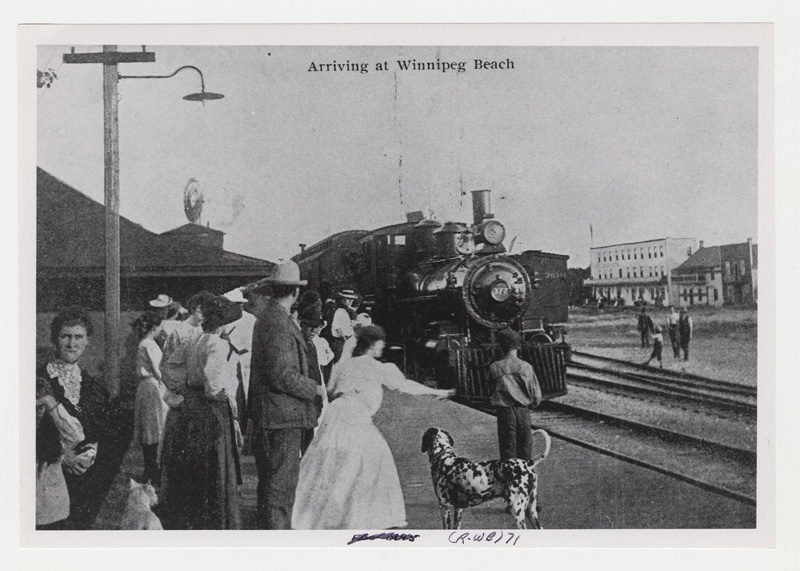“On that warm summer evening, the excitement growing on the Railway Street (Main Street) was a stark contrast to the rest of Winnipeg, which was peacefully drifting into sleep. With their talk and laughter, the young showed impatience waiting for the Moonlight Special to take them on a trip of excitement, long-awaited meetings and the joy of dancing at Winnipeg Beach. The train pulls into the station and announces its arrival with the horn. Boarding begins. The conductor will have to keep an eye on lights in the train as switching off is favorite pastime for the youthful passengers while traveling to the beach. Dispatcher is wagging his red hat – it’s time to go…”
Sanja Rossi
The magnificent crescent of sandy beaches at Lake Winnipeg became the favorite place during summertime in the early 20th century. Some enjoyed peace and rest in nature spending quality time with families and friends, while others were looking for little excitement and fun. The rapid industrial development of Winnipeg at the beginning of the 20th century and increasing population of both the middle and upper class gave rise to the need for quality social gatherings, outings and vacations.

Sir William White, general manager of all CPR lines west of Lake Superior in 1896, was the first who had recognized and discovered the potential of Lake Winnipeg Beach. In 1900, he discovered a three-mile-wide arch of fine sand beach on the west shore of Lake Winnipeg, and he had the CPR purchase 330 acres of beachfront land. By 1925, Winnipeg Beach was Western Canada’s greatest resort.
CPR officials planned to build a dancing pavilion, cottages and a hotel. The first dance pavilion was built in 1902, about 300 yards north of the station and it could accommodate 2,500 dancers. The pavilion included a restaurant and confectionery, offices, kitchen and lunchroom, moving picture theater and billiards. Soon, this first pavilion proved to be too small. The second pavilion was built with a concrete foundation and fir frame construction. After the World War dancing became very popular. A new pavilion that housed a 14,000 square foot dance floor opened in June 1924 and was considered the largest dance hall in Western Canada.
Winnipeg Lake western shoreline became so popular that 13 trains a day would take people to the beach. The Moonlight Special train ran every Saturday evening in summer for over 50 years from Winnipeg to Winnipeg Beach. The train was indeed “special” back in the heydays. After a long week, it would take both young and old to the promenade, dances, concerts and swimming, all that for 50 cents.
There were also another two trains, the Picnic train and Daddy’s train. Picnics were another way of making sure that people regularly came to the beach and were held by ethnic or church groups to bring their communities together and nourish the sense of belonging.
The boardwalk along the beach, piers, a wooden roller coaster (which was one of the largest in the country), a pavilion …all that was built to provide an oasis of peace in nature for people from the city who wanted to break free from the constraints of urban life. Weekend boat regattas used to attract as many as 10,000 people to the shores.
The beach was colonized by the middle class. Families of businessmen used to spend summer on the beach. On weekdays, fathers traveled to work in the city, and on Fridays, the family eagerly awaited Daddy’s train to bring them all together for the weekend at the beach. CPR did have earlier plans to develop the hotel, but it was Edward Windebank who suggested this project to the CPR. Whyte supported the idea of building the Empress hotel both financially and as an idea to provide high-class accommodation for Winnipeg’s elite, thus making sure that they were among the regular clientele of the beach. The Empress hotel, with its 80 rooms, became the symbol of the resort. Its facade was surrounded by a large veranda. It burned down in 1935.
The arrival of the economic depression, changes in the way of life and the world war thwarted the happy summer days on Winnipeg Beach. Moonlight and Daddy’s trains no longer returned. The popularity of the beach began to decline in the 1950s, and in 1961 the CPR suspended passenger service completely. The amusement park was closed in 1964. The beach was redeveloped by the Provincial Parks Branch into day-use recreation until 2011 when a full service campground was opened.
